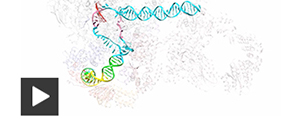Working at temperatures near absolute zero, scientists at Berkeley Lab and UC Berkeley have captured images of proteins at work in the early steps of DNA transcription.
DNA unfolding to make RNA. RNA appears briefly in bright red. (Credit: Eva Nogales)
The first key steps in gene activation involve the unzipping of DNA’s double helix so that the single strand of genetic code is exposed and available to be copied into messenger RNA. Little had been known about the molecular cues that triggered the double-stranded structure to open up. Researchers used cryo-electron microscopy (cryo-EM) to obtain data and images of the human molecular machinery engaged with DNA at a near-atomic level of resolution.
Eva Nogales, a senior faculty scientist at Berkeley Lab, UC Berkeley professor of biochemistry and a Howard Hughes Medical Institute (HHMI) investigator, led the new study, published today in the journal Nature.
This latest research comes seven weeks after Nogales unveiled an earlier milestone using cryo-EM technology to image details of transcription factor TFIID in gene expression. That study was also published in Nature.
To read the full UC Berkeley press release on the newest Nature paper, click here.
